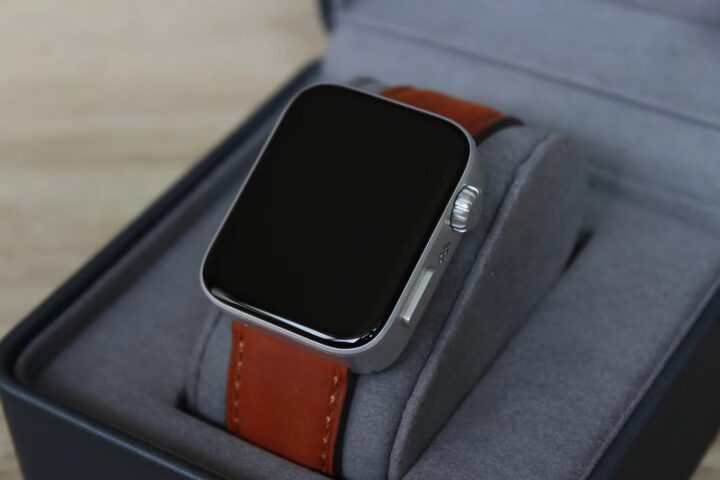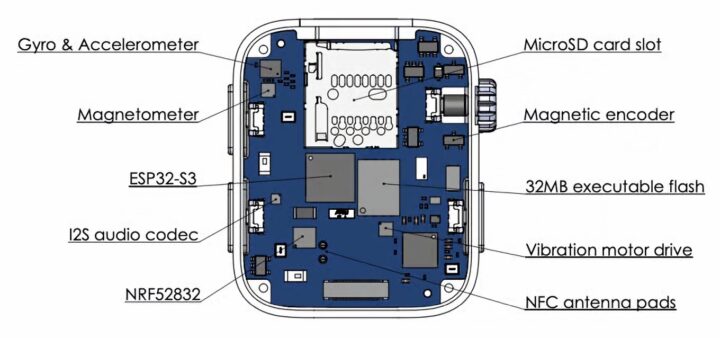Spectra is a JavaScript-based hackable smartwatch based on the ESP32-S3 WiFi and Bluetooth microcontroller that aims to offer the quality of high-end consumer smartwatches with the repairability of a maker-targeted device.
The Spectra smartwatch combines the ESP32-S3 microcontroller with a Nordic Semi nRF52832 co-processor to optimize the battery life. The ESP32-S3 is maxed out with 8MB of RAM and 32MB of external flash memory, and the microSD card slot in the watch supports up to a 512GB memory card.
It shares a similar concept with the Bangle.js and the Bangle.js 2 customizable smartwatches. According to the maker, Spectra is not bound to be fully open-source, since the project uses “external proprietary code [they] aren’t allowed to share.” They plan to publish Arduino libraries and hardware design files, but there is no live GitHub repository yet.
Other hackable smartwatches include the TinyWatch S3, the ZSWatch, and the Sensor Watch Pro.
Spectra specifications:
- MCU – ESP32-S3 SoC, dual-core XTensa LX7 @ up to 240 MHz; 512KB SRAM; Integrated 2.4GHz Wi-Fi and BLE
- Co-processor – Nordic Semiconductor nRF52832 ARM Cortex-M4F @ 64 MHz with 512KB Flash, 64KB RAM, Bluetooth 5.4 LE connectivity
- Memory – 8MB RAM
- Storage – 32MB flash, microSD card slot (supports up to 512GB)
- Display – 368 x 448 OLED display
- Sensors
- Magnetic encoder
- Magnetometer
- Gyroscope & accelerometer
- PPG (photoplethysmogram) sensor
- Misc – Speaker, Microphone, 4x user hotkeys (including crown), 4x contact pins on the rear (USB and charging), aluminum housing
- Debugging/Programming – Full SWD debug port on the rear of the watch
- Battery – TBD
- Dimensions – 42.60 x 35 x 10.95mm watch body, with standard 22mm watch straps
SpectraOS is the customizable smartwatch’s operating system and supports “coordinate-based GUI, modular drivers, and dynamic features.” It is designed to be backward compatible with future Spectra smartwatches and will run first-party and third-party applications downloadable from an app store. The company also offers a software development platform that supports live coding with a simulation of the smartwatch.
The Spectra project is live on Kickstarter and more than halfway to its funding goal of $32,559. There are three available rewards: Super Early Bird (about $216), Early Bird (about $260), and Spectra (about $282). Optional add-ons include micro SD cards, a watch box, and stainless steel housing. Orders are expected to ship by July 2025.
Via Hackster.io

Tomisin is a writer specializing in hardware product reviews, comparisons, and explainers. He is very passionate about small form factor and single-board computers.
Support CNX Software! Donate via cryptocurrencies, become a Patron on Patreon, or purchase goods on Amazon or Aliexpress







I wonder why they have two wireless MCUs.. I guess the esp is for display, UI, and WiFi, and the nrf for ble and peripheral data collection.
All in all, sounds like a neat, yet beefy, little package
neat, beefy, little brick 🙂
until someone reverse engineers/replaces the proprietary code?
Where is this Javascript implementation for the ESP32? I have been using Lua instead.
Two MCUs is so that they can completely power off the ESP32-S3. I work with the TI equivalent of the nordic chip and it can run for years at 1/50th the power the ESP32-S3 uses when in deep sleep.
There is no way this needed 8MB of memory and 32MB flash and an SD card? That display is likely based off the RM69090 which supports 8080 mode with an internal framebuffer. Given that you have the SD card, this should have used the ESP32-S3FH4R2.
There is much which could be eliminated in this hardware design. Power consumption is going to be poor.
Would you mind elaborating on compatibility, or suitability, of microSD cards with different ESP32 chips?
I think it’s a plus when storage on a smart watch can be expanded by the end user with a microSD card, so I’m interested in learning what else to look out for in the few models that have this feature…
I have no clue why someone would want to expand the storage on a smart watch. But it is easy and cheap to add a microSD socket to an ESP chip. Maybe for more app storage? Do people really use 500 apps on a watch?
Well when you think about it, a lot of smart watches already run Android so why not convert them to run on GNU/Linux? There are already some attempts in that direction with AsteroidOS and PostmarketOS but I can imagine others wanting to run NixOS – at which point people will want to use FlatPaks and simlink them to microSDs so they don’t bog down the non-replaceable storage.
Even if you don’t think that’s likely, what about storing high quality music files locally so you can still play music to your wireless earphones if your phone’s out of battery/not around.
Ideally the end user (especially not-very-techy end users) should be able to access such a facility with minimal effort (so not having to solder on a microSD reader) and what I meant about compatibility/suitability was regarding the part of your comment where you talked about power consumption and you stated that for microSD the project should have used a specific ESP32 chip…
How do the different ESP32 chips affect microSD power consumption and are there other considerations you should take into account when choosing an ESP32 with which to use a microSD?
If you want to run Linux in a watch use a camera chip like the RV1103 which is quite cheap. https://www.aliexpress.com/item/3256806095572656.html
Just ignore the camera, you are after the internal DRAM and LCD controller.
Then add on an external wifi/BLE chip.
how long you can “play high quality music to your wireless earphones” before the small watch battery is empty? or maybe you’ll have big watch for music and maybe voice calling or internet and then small watch to actually tell you the time and show alarms/reminders, if your big watch is out of battery/not around?
Ever heard of BLE?
Ever heard of no LE audio support whatsoever on both ESP32 S3 and nrf52832? And in fact unlike other older ESP32 chips the S3 has no classic bluetooth support either so even no A2DP. So in fact this watch cannot do bluetooth audio at all, you are out of luck.
And BTW, if you would really have LE audio headphones (nowadays still quite unlikely) you would need at least nrf5340 or esp32 H4 (as per https://github.com/espressif/esp-idf/issues/12277#issuecomment-2249773871 ) to have any chance of LE audio support.
This chip would be much better for this project given the requirements.
https://www.cnx-software.com/2024/10/08/nxp-rw612-arm-cortex-m33-wireless-mcu-offers-wi-fi-6-bluetooth-5-4-and-802-15-4-radios/ and it comes in a tiny WLCSP151
Thank you for this – and your previous reply about camera chips – very handy to know!
Right! Thank you for the explainer, that was helpful!
Store music may be
I don’t get the attraction, and who wrote that it would be “backward compatible with future Spectra smartwatches”. What?
It’s all bricks and wire jiggles until they turn out a proper 140m dive watch that can stably use M.2 or μSD, take your pulse and ecg continuously, offer spectroscopy and canon glucose measurements, maybe some microscopy and MS/MS, take gesture, pose and gaze tracking input, plus inertial X GLONASS. Maybe offer more optical breakout areas in the watch body to do gimbal’d laser indicators, lifi, test lead connections…
What exactly is the esp for? Is there anything you need in a smart watch that profits of the esp32 vs the nrf? WiFi? Really?
I still don’t understand who the target audience is and what problem does this watch solve?! If it’s about maker hobby programming and tinkering, then M5stick plus2 (or something similar) is probably a much better option – for which you have to sell your kidney to buy it, and if you just want a fancy clock, then advanced programming is probably an obstacle for you, and for that money you can get more than a good smartwatch with many options.
For example, if the watch has some of the new NN chips on which it could drive some fitness or custom NN models without much power consumption, then it would make sense in the wristwatch format.
You can push the NN model to the esp32, but don’t expect the battery to last.
The new layout is terrible, it makes it much more difficult getting a proper overview of the articles
What new layout? I haven’t changed the website design in years.
Pricy for a watch that looks like that and with no health tracking features